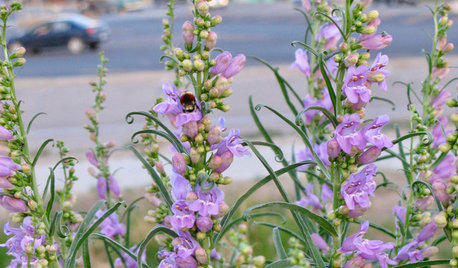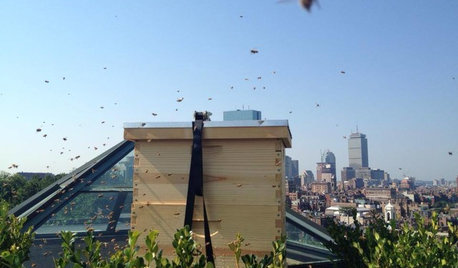Food past best by date. How long would you still eat it?
dedtired
last year
Featured Answer
Comments (79)
matthias_lang
last yearlast modified: last yearRelated Discussions
If you had a choice to eat GMO foods, would you? Yes/No
Comments (76)The following was stated: "Glyphosate breakdown via heat produces mostly aminomethylphosphonic acid, carbon monoxide/dioxide, amino acids, and water/vapor...similar to microbe breakdown, but a lot faster. ." H.Kuska comment. I am aware of the microbe breakdown products, but I am not aware of any references that state that the thermal breakdown is similar. The melting point of glyphosate is nearly 230 degrees C. That would be nearly 446 degrees F. This is the main thermal paper that I have been able to find so far. Unfortunately it does not identify the glyphosate decomposition products. Howver, it appears to me that very little glyphosate would actually decompose in normal hosehold use. The first observed decomposition product is: "By analyzing the infrared spectrum of the sample which is processed by rising temperature to 260 C at the heating rate of 6 C min-1, the most possible group loss in this stage may be methylene. Moreover, the mass loss in the first stage by TGA is in accordance with the mass loss of a group of methylene in the molecular of glyphosate." Then. "With the temperature increased, the second stage appeared the exothermic peak after a smaller main endothermic peak, and the lost mass had continued, which indicated that this stage might occur burning phase, thus exothermic phenomenon occurred. By analyzing the infrared spectrum of the sample which is processed by rising temperature to 360 C at the heating rate of 6 Cmin-1, the most possible group loss in this stage may be the group of carbonyl. Moreover, the mass loss in the second stage by TGA is in accordance with the mass loss of a carbonyl in the molecular of glyphosate." Now Canola Oil has a smoke point of around 238 degrees C, so I doubt that the glyphosate is breaking down very much in normal Canola Oil use. http://www.culinary-yours.com/frying_oil.html Of course, if you can document your answer, I am willing to look at the reference. Here is a link that might be useful: link to thermal study...See Morehow long can you keep food scraps for?
Comments (8)yea i decided not to freeze it after all because my family will become very violent when they find rotting food in the freezer. they don't garden and the ones who do like my dad don't even know what composting is. in the end im just keeping it in a tuppawear container and when it does over flow i will resort to a 5gal bucket with a lid. this way it has time to decompose at least unlike before where i just put in the food fresh and it takes like a week just to start molding and is still untouched. i found out the hard way that they like the moldy stuff better then the fresh stuff...See MoreWhere would you go to eat a favorite food from childhood?
Comments (44)some of my fav's still around include hamburgers at Redamaks in New Buffalo MI and yes I do drive to MI from Chicago just for their hamburgers LOL. We used to have a summer place in New Buffalo MI and that place is THE place to go for lunch & dinner. I still always visit Teibels in Schereville IN when in NW IN seeing friends, I always have the Walleye grilled. My DH makes us stop at Zel's for barbeque sandwiches & plain pulled pork in Hammond IN and Schoops for hamburgers - he won't drive to MI LOL. House of Pizza in Hammond IN when I'm in the mood for square cut, thin pizza. A few fav's long gone include Puntillo's Restaurant, growing up we used to eat fish (either lake perch or breaded cod) there every Friday, they closed up in the mid 80's :-( Ralphs Pizza we used to get pizza delivered on Sat nite or Sundays for Cubs or Bears games when I was little. There was also an awesome DQ around the corner from my house, we used to bug my dad to walk over there and get us a bag of dilly bars in the summer, when we were too little to go by ourselves LOL. Food was very different back then, I rarely find a place to go out to eat that is as good as the restaurants I grew up with :-( ~ liz...See MoreROLL CALL: Who is still here and how long have you been here?
Comments (74)Hi garden_gal and Irma, it’s so good to hear from you both again and gratifying that you remember my little garden. In answer to your questions, we do still live in the same house. The garden looked wonderful for several years but the shrubs eventually grew very large and many of the plants died off or had to be removed. I have found it increasingly difficult to find pesticide free butterfly host plants and attractors but this is my mission again this year. The garden has evolved but I am happy to report that it is indeed still alive with butterflies, bees and hummers!...See Moremaire_cate
last yearnickel_kg
last yearlast modified: last yeardedtired
last yearElmer J Fudd
last yearjrb451
last yearrob333 (zone 7b)
last yearcarolb_w_fl_coastal_9b
last yearRNmomof2 zone 5
last yearElmer J Fudd
last yearlast modified: last yearZalco/bring back Sophie!
last yearToronto Veterinarian
last yearlast modified: last yearLars
last yearElmer J Fudd
last yearnicole___
last yearToronto Veterinarian
last yearlast modified: last yearElmer J Fudd
last yearElmer J Fudd
last yearlast modified: last yearlucillle
last yearlast modified: last yearElmer J Fudd
last yearZalco/bring back Sophie!
last yearlast modified: last yearlucillle
last yearElmer J Fudd
last yearnicole___
last yearnickel_kg
last yeardedtired
last yearElmer J Fudd
last yearJasdip
last yearElmer J Fudd
last yearlast modified: last yearJupidupi
last yearKathsgrdn
last yearnickel_kg
last yearElmer J Fudd
last yearZalco/bring back Sophie!
last yearnickel_kg
last yearElmer J Fudd
last yearnickel_kg
last yearlast modified: last yearToronto Veterinarian
last yearlast modified: last yearElmer J Fudd
last yearsushipup2
last yearWittyNickNameHere ;)
last yearkevin9408
last yearToronto Veterinarian
last year
Related Stories

GARDENING GUIDESDoes Your Garden Welcome Wildlife Visitors With Something to Eat?
Learn which flowers and plants provide essential food for pollinators and other beneficial wildlife
Full Story
HEALTHY HOME12 Ways to Set Up Your Kitchen for Healthy Eating
Making smart food choices is easier when your kitchen is part of your support team
Full Story
KITCHEN DESIGN16 Scrumptious Eat-In Kitchens and What They Want You to Serve
Whether apple-pie cheerful or champagne sophisticated, these eat-in kitchens offer ideas to salivate over
Full Story
FARM YOUR YARDHello, Honey: Beekeeping Anywhere for Fun, Food and Good Deeds
We need pollinators, and they increasingly need us too. Here, why and how to be a bee friend
Full Story
HOUSEKEEPING9 Kitchen Organizing Tips to Help You Waste Less Food
Follow these simple steps to maximize your budget and turn your good intentions into good habits
Full Story
FARM YOUR YARD6 Things to Know Before You Start Growing Your Own Food
It takes time and practice, but growing edibles in the suburbs or city is possible with smart prep and patience
Full Story
KITCHEN DESIGNKitchen of the Week: Turquoise Cabinets Snazz Up a Space-Savvy Eat-In
Color gives a row house kitchen panache, while a clever fold-up table offers flexibility
Full Story
LIVING ROOMSLiving Room Meets Dining Room: The New Way to Eat In
Banquette seating, folding tables and clever seating options can create a comfortable dining room right in your main living space
Full Story
CRAFTSMAN DESIGNHouzz Tour: Bridging Past and Present in a California Craftsman
A Santa Monica bungalow says goodbye to gloominess and hello to a bright new look that mixes modern and traditional
Full Story
KITCHEN DESIGNWorld of Design: Favorite Recipes From Food Lovers Around the Globe
Travel with your tastebuds and experience for yourself these international foodies' favorite dishes
Full StorySponsored
Columbus Area's Luxury Design Build Firm | 17x Best of Houzz Winner!




amylou321